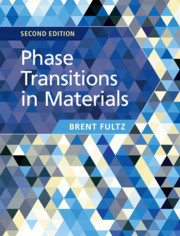Book contents
- Frontmatter
- Contents
- Preface
- Notation
- Part I Basic Thermodynamics and Kinetics of Phase Transformations
- 1 Introduction
- 2 Temperature–Composition Phase Diagrams
- 3 Diffusion
- 4 Nucleation
- 5 Effects of Diffusion and Nucleation on Phase Transformations
- Part II The Atomic Origins of Thermodynamics and Kinetics
- Part III Types of Phase Transformations
- Further Reading
- References
- Index
2 - Temperature–Composition Phase Diagrams
from Part I - Basic Thermodynamics and Kinetics of Phase Transformations
Published online by Cambridge University Press: 24 April 2020
- Frontmatter
- Contents
- Preface
- Notation
- Part I Basic Thermodynamics and Kinetics of Phase Transformations
- 1 Introduction
- 2 Temperature–Composition Phase Diagrams
- 3 Diffusion
- 4 Nucleation
- 5 Effects of Diffusion and Nucleation on Phase Transformations
- Part II The Atomic Origins of Thermodynamics and Kinetics
- Part III Types of Phase Transformations
- Further Reading
- References
- Index
Summary
Chapter 2 explains T–cphase diagrams, which are maps of equilibrium alloy phases in a space spanned by temperature T and chemical composition c. The emphasis is on deriving T–c phase diagrams by minimizing the total free energy of an alloy with two or three phases. The lever rule and common tangent constructions are developed. Some basic ideas about chemical interactions and entropy are used to justify of the free energies of alloy phases at different temperatures. For binary alloys, the shapes of free energy versus composition curves and their dependence on temperature are used to deduce eutectic, peritectic, and continuous solid solubility phase diagrams. Some features of ternary alloy phase diagrams are discussed. If atoms are confined to sites on an Ising lattice, free energy functions can be calculated with a minimum set of assumptions about the energies of different atomic configurations. These generalizations of chemical interactions are useful for identifying phenomena common to unmixing and ordering transitions, but warnings about their limitations are presented.
- Type
- Chapter
- Information
- Phase Transitions in Materials , pp. 21 - 58Publisher: Cambridge University PressPrint publication year: 2020

